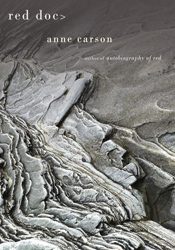
Reading Anne Carson is like rummaging a child’s desk drawer: here a leaf, there a scrappy volume of poetry, a rock. She collects. The pleasure, the joy in her work comes from her ability to skip about, from Greek myth to Elvis to war to Proust to television to herding musk oxen, and make it all a single strange, peculiar knot.
Red Doc> follows the story told in Autobiography of Red, in which Geryon the red, winged boy-monster falls in love with Herakles. Autobiography was a powerful book in its own right, a collage of childhood and wakening sexuality. And while there is a continuous thread, Red Doc> is its own book, with a new feel, different rhythms and shifted characters. Geryon here is simply G; Herakles is back from the war with PTSD, and goes by Sad. Autobiography masquerades as a scrapbook-memoir, Red Doc> reads like a screenplay, with a film’s concision and agility.
Red Doc> is a series of threads and events presented in composite. Like the photograph Carson herself took and used for the book jacket, it presents as both a topo map of a particular terrain (love, trauma, memory) and the layering of consecutive images that builds that terrain. For both G and the war vets time and memory have become frayed, unspliced: “Too much / memory is the problem.”
Time and events slide around, doing and undoing themselves: G caring for Sad, G tending to his herd of musk oxen, Hermes running on the highway in a silver tuxedo, a road trip that deadends in the fissure of a glacier, a volcanic eruption, a veterans’ rehabilitation clinic and a car garage, G’s mother on her deathbed.
It seems worth noting here that Carson has a reputation for difficulty, which is actually identical to her sense of playfulness. Red Doc> deploys, for example, the phrase “10-gallon asshat” without breaking stride; it is dedicated to “the randomizer.” Whimsy and obliquity dance hand in hand. As usual, her lines here have that bright, freshly-washed quality of Greek verse in translation. Red Doc> remains, for the most, lucid and accessible, vernacular, friendly even, without sacrificing its iridescent, surrealist sheen.
It’s that surrealism, that insistent oddness which is most striking about it. The book as a whole follows the same rules observed by G when he falls into the glacier, “a / world at once solid and / dissolved but weirdly / shadowless as if without / dimension.” It’s a world where ice bats fly, where a rehab clinic looms on a glacial shelf, where a vet named 4NO is blind to actual sight and lives by seeing exactly five seconds into the future, always.
Fragments, scraps, holographic memories. Reading Red Doc> is like being plunged under an iceberg: same world, same old friends, strange new light. Who is Hermes meeting as he sprints alongside the highway? “A stranger,” he says. “How / will // you recognize each other” Ida wonders? “In a strange way”.
To be welcomed into Red Doc> is to be made a stranger, put in new territory: “am I talking outside / your experiential zipcode”, we are asked? The book itself is a sort of monster hybrid, foil to Geryon’s monstrosity. Like all Carson’s work it flirts with the nebulous space between novel, poetry and drama. The very name Red Doc>, the notation of a computer file, marks its openness, its flex, its susceptibility to revision: “little snags come tumbling / out of the text.” It’s a book about departures, escapes, trips, returns, flights and falls. This a story exhilarating in its ellipticism, a book that exults the odd.
And why poetry, and why so strange? Like G, whose monstrous shape is both the root and the result of his strangeness, poetry is simply the shape these characters’ lives take: “there are times / your life gets like that”, Ida says at one point, meaning the difference between poetry and prose. Poetry is a state of trauma, a jag in memory, the confusion these characters live in and their way through. Poetry and oddness are the only possible home for G and Sad’s idiosyncrasy, for their queerness that exceeds their homosexuality, their love for one another.
 Like a conjuror, Carson calls her story to life with the preliminary statement (her jacket copy) that “To live past the end of your myth is a perilous thing.” With little concern for continuous names or chronology, the story of Geryon and Herakles resumes an ancient myth, crosses books, lives in the hands of many storytellers, becomes multiform; it splinters, rejoins, wears a new face; their story exceeds the confines of singles lives, single volumes. Carson bends time. She contracts universes: through everything, the living wire is the way Geryon and Herakles are married by fate and live out their different possibilities.
Like a conjuror, Carson calls her story to life with the preliminary statement (her jacket copy) that “To live past the end of your myth is a perilous thing.” With little concern for continuous names or chronology, the story of Geryon and Herakles resumes an ancient myth, crosses books, lives in the hands of many storytellers, becomes multiform; it splinters, rejoins, wears a new face; their story exceeds the confines of singles lives, single volumes. Carson bends time. She contracts universes: through everything, the living wire is the way Geryon and Herakles are married by fate and live out their different possibilities.
Because after everything Red Doc> is consummate love story, a book about friendship, companionship, motherhood, sex. It charts the failures of mutations of love, their imperfections, their infidelities and deflations: the strangeness of how they actually manifest. The realization that “not every day / can be a masterpiece.” Autobiography of Red was a story of dawning to your own peculiar monstrosity. Red Doc> is what happens when that peculiarity finds its full form, when it stretches, unfurls, lives beyond the confines of your life




